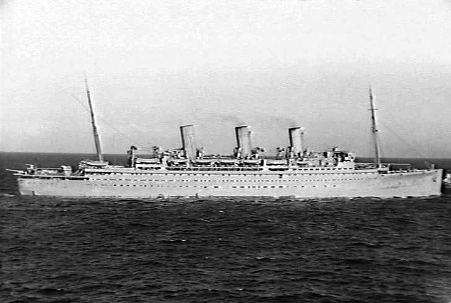Port of registry 1922-1939 Canada Launched 17 August 1920 Tonnage 19.52 million kg | Ordered 1920 Length 191 m Beam 24 m | |
 | ||
Name 1922-1943 RMS Empress of Canada Owner 1922-1943 Canadian Pacific Steamships Operator 1922-1939 Canadian Pacific Steamships1939-1943 British Admiralty Cost approximately $6,800,000 Builder Fairfield Shipbuilding and Engineering Company | ||
RMS Empress of Canada was an ocean liner built in 1920 for the Canadian Pacific Steamships (CP) by Fairfield Shipbuilding & Engineering Company at Govan on the Clyde in Scotland. This ship—the first of two CP vessels to be named Empress of Canada—regularly traversed the trans-Pacific route between the west coast of Canada and the Far East until 1939.
Contents
History
In 1920, Canadian Pacific Steamships ordered a new ship to be built by Fairfield Shipbuilding & Engineering Company at Govan near Glasgow in Scotland. This Empress was a 21,517 ton, 653-foot ocean liner. The ship was launched 18 August 1920 with a notable speech by the general manager of the Canadian Pacific Ocean Services, Ltd., Sir Thomas Fisher, noted the approximately $6,800,000 price compared to a pre-war cost of about $2,200,000 and cost of operation that had risen at least 350 per cent had forced first class fares from $76 to $202 (based on a $4 to the pound sterling) and predicted dire consequences for shipping and the British Empire. A planned world tour, planned for the spring of 1921, was announced cancelled due to labor disturbances making on schedule completion doubtful.
She undertook her maiden voyage on 5 May 1922. Based at the port of Vancouver, British Columbia, Canada, the first Empress of Canada was intended to provide service to Japan, Hong Kong, and China. She was at the time the largest vessel ever engaged in transpacific service. Her sister ships included Empress of France and Empress of Britain.
Great Kantō earthquake
On 24 September 1923, Empress of Canada arrived at Tokyo harbor—just three days after the devastating Great Kantō earthquake struck the city. She found that the Canadian ocean liner RMS Empress of Australia had been converted to a command post from which the British consul was directing relief work, and the Empress of Canada transported refugees – 587 Europeans, 31 Japanese, and 362 Chinese – to Kobe, Japan.
On 13 October 1929, Empress of Canada ran aground off Vancouver Island, British Columbia, Canada. Ninety-six passengers were taken off by tender and landed at Victoria, British Columbia. She was refloated on 15 October and towed to Esquimalt, British Columbia, for drydocking.
World War II
Following the outbreak of World War II in 1939, she was converted for use as a troopship. She was one of the ships in the first Australian/New Zealand convoy, designated US.1 for secrecy, destined for North Africa and at that time not yet fully converted for full troop capacity with few ships of the convoy carrying more than 25% more than their normal passenger load. Empress of Canada departed Wellington 6 January 1940 with the New Zealand elements, joined the Australian ships and arrived Aden on 8 February from where the convoy split with all ships heading for Suez.
She continued to transport ANZAC troops from New Zealand and from Australia to the war zones in Europe until sunk. The return voyage from Europe was not less dangerous than the trip north had been. On 13 March 1943, while en route from Durban, South Africa to Takoradi carrying Italian prisoners of war along with Polish and Greek refugees, the SS Empress of Canada was torpedoed and sunk by the Italian submarine Leonardo Da Vinci approximately 400 miles (640 km) south of Cape Palmas off the coast of Africa. Of the approximate 1800 people on board, 392 died. Nearly half of the fatalities reported were Italian prisoners.
